
| Station Name: BACKWORTH (2nd) |
 |
[Source:
Alan Young]
| Date opened: |
27.6.1864 |
| Location: |
Immediately north-east of Northumberland Park (Metro) station. West side of Station Road (B1322) |
|
| Company on opening: |
Blyth & Tyne Railway |
| Date closed to passengers: |
13.6.1977 |
| Date closed completely: |
13.6.1977 |
| Company on closing: |
British Rail (Eastern Region) |
| Present state: |
Demolished |
| County: |
Northumberland |
| OS Grid Ref: |
NZ309712 |
| Date of visit: |
June 1962, Mar 1972, Dec 1976, July 1977, Dec 2007 & 24.3.2009 |
Note: Note: The station opened as Hotspur and was renamed Backworth from the timetable of June 1865.
The two platforms were on a curve of 17ch radius. Until the early 1970s a bridge carrying the Backworth Waggonway (see Backworth Colliery entry) crossed the station halfway along the platforms.
Set back from the up platform, the original station office building was of Tudor Gothic design (illustrated in W Fawcett A History of North Eastern Railway architecture Vol 2) similar in style to South Gosforth and Jesmond’s buildings, and it survived until about 1972.
 |
Also on the up platform was a single-storey brick structure with closely set twin pavilions containing waiting rooms, each with stone bay windows projecting onto the platform, and topped with stone finials. A short awning linked the pavilions. This building survived until the station’s demolition in 1977. On the down side a pent-roofed brick shelter with a glazed front was |
replaced in the mid-1960s with a metal-and-glass ‘bus shelter’. Apparently, owing to an oversight, the new shelter was built lacking an entrance!
In about 1885 the booking office functions had been transferred to a wooden shed on the overbridge at the north-east end of the station, which also served as the footbridge to connect the platforms. A range of windows overlooked the platforms. (A similar building appeared at Seaton Delaval.) A small extension was added to the north end of this overtrack building in the 1920s. The original building assumed the new role as the stationmaster’s house.
Under LNER administration Backworth station was fitted with nameboards of a design that was probably unique to the Coast Circle stations incorporating the company’s early diamond motif: in effect a spike above and below the centre of the board, and these were in place until about 1959 when BR(NE) vitreous enamel signs replaced them. The LNER also installed swan-neck electric lamps and nameplates, and in about 1962 BR(NE) totems replaced the LNER nameplates; only six of the Coast circle stations were favoured with totems. In 1971 tall ‘vandal-proof’ lamps replaced the LNER ones, and the totem signs disappeared. Corporate identity signage was fitted in 1973, although a BR(NE) ‘Passengers must not cross the line except by the footbridge’ sign was in place on the up platform even after closure.
| The first Backworth signal box was opened on 23 August 1880 originally located south-east of the tracks and immediately east of the Station Road bridge. It was extended, or a new box was built, in 1904 in connection with the NER electrification. This box was replaced on 16 November 1958 with a structure in the apex of the junction where the lines to Monkseaton and |
2.gif) |
Blyth diverged, which itself was closed on 1 March 1964 when operations transferred to a new box at Benton (adjacent to the ECML). The Backworth box was demolished on 16 November 1970.
Blyth and Newbiggin trains to and from Manors North called at Backworth until their withdrawal in November 1964, allowing interchange with local Coast electric train services.
 |
Whereas most of the ‘Coast Circle’ line was through densely built-up urban areas, until the 1930s there was very little housing development between Benton and Monkseaton. In 1911 the NER noted that the station served a population of only 9,914. In the 1950s there was still little line-side housing in the Backworth area, and it was the least used station on the Coast Circle. |
The station closed in 1977 - almost a year before the line was closed to passengers for conversion into the Metro light rail route - and it was swiftly demolished. When the line reopened Backworth was replaced with a station half-a-mile east at Shiremoor, but in 2005 Northumberland Park station opened a short distance south-west of Backworth, beyond the Algernon Drive overbridge.
BRIEF HISTORY OF BLYTH & TYNE RAILWAY (Newcastle [New Bridge Street] – Jesmond – Benton – Backworth)
The southern end of the Blyth & Tyne Railway has a complicated history. Until 1861 there was a single route from Blyth and Seghill onward through Prospect Hill to Percy Main, with a terminus adjacent to the NER station. However in that year a new branch
was opened, following the route of the former Whitley Waggonway, extending from Hartley to Tynemouth. It should be noted that this included the stretch to what is now Monkseaton, which was to be known as the ‘Avenue Branch’, and that the line beyond to Tynemouth was half a mile inland of the present day Monkseaton – Tynemouth Metro line.
At the Tynemouth end the original terminus was quickly replaced with a new one on a short branch which curved south eastwards, and that in turn closed when its branch was extended to a third terminus, which adjoined the 1847 Tynemouth terminus of what had been the Newcastle & North Shields Railway.
| In 1864 the Blyth & Tyne reached Newcastle, with a terminus at New Bridge Street. This was achieved by diverting trains onto a new line just south of Holywell, then through Backworth, Benton, and Jesmond. At Backworth a new line was opened to join the 1861 Whitley (Monkseaton) to Tynemouth route. Trains could now travel on the B&T from Newcastle (New |
 |
Bridge Street) to Tynemouth, making the Holywell – Prospect Hill – Percy Main route, and the ‘Avenue Branch’ between Hartley and Whitley (Monkseaton) redundant. These two lines closed in June 1864 on the day when the Newcastle – Tynemouth service was inaugurated.
In 1874 the B&T was absorbed by the NER, and the opportunity was taken to reorganise the railway routes in the Monkseaton / Whitley / Tynemouth area. With the growth of housing and holidaymaking on the coast the ‘inland’ route from Monkseaton to North Shields was superseded in 1882 by one within sight of the sea, and the two formerly competing termini at Tynemouth were replaced with a splendid new through station. This created the coastal section of the familiar Coast Circle and Metro route, although there were to be realignments at Whitley Bay in 1910 and Monkseaton in 1915 where new, larger stations were built.
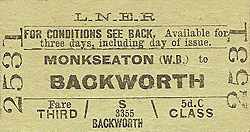 |
In response to the growth and electrification of street tram networks on North Tyneside the Coast Circle route via both Wallsend and Carville was electrified in 1904 on the third rail system, and the irregular and infrequent steam service was replaced with a frequent interval service. For almost six decades the basic pattern was three trains per hour in each direction, with |
extras in the rush hour.
 |
In 1963 the Reshaping of British Railways (‘Beeching’) report made no reference to the main Coast Circle line, but the Riverside Branch, via Carville, was recommended for closure (which was eventually implemented in 1973). However on a visit to Tyneside shortly after the report’s publication Beeching made it clear that the Coast Circle line was a likely candidate for closure. In the mid 1960s the ageing electric multiple units, dating from 1937, were being allowed a few more minutes to complete their journeys, and the decision was made to replace them with diesel multiple units cascaded from other areas rather than with newer electric stock. In June 1967, shortly after the line became part of British Rail’s Eastern Region – the North Eastern having been abolished - the last EMUs ran, and the third rails were removed.
| The service of three stopping trains per hour in each direction was replaced with a half-hourly service, plus one ‘express’ serving only the coastal stations, Wallsend and Manors; it is no surprise that custom was lost at the stations whose service was cut. However in October 1970 the tide turned, and the Eastern Region launched the vigorous Tynerider campaign to revitalise |
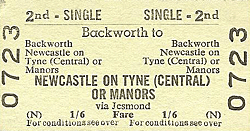 |
the line (including the Riverside branch) and the South Shields branch. Although the Riverside continued to have a sparse service at rush hours only, the Coast Circle’s 20-minutely service returned, with the new feature of trains in the early hours to bring revellers home from Newcastle city centre. Passenger numbers increased dramatically, and strengthened the case for further investment. The idea of incorporating the local railways into a rapid transit system was examined, and in 1973 Royal Assent was obtained to use the Coast Circle as the basis of such a network, which was to become the Tyne & Wear Metro.
The engineering work to bring about this transformation was ambitious, involving the driving of tunnels under central Newcastle and Gateshead and constructing a sixth bridge over the Tyne between these centres, so that the Metro could be separated from the ‘main line’ system. For some time between January 1978 and November 1982 all of the stations on the Coast Circle (except Tynemouth) were closed for conversion work to be done: this included West Jesmond, South Gosforth, Longbenton, Benton, and West Monkseaton on the former B&T Newcastle route, thus their inclusion in the list of Disused Stations. Backworth closed in 1977 and Manors North in 1978 and were not to reopen on the new Metro line (although Manors underground station replaced Manors North, and Northumberland Park was opened in 2005 immediately south-west of the site of Backworth).
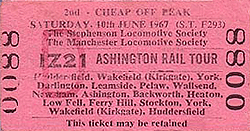 |
Almost all of the Newcastle – Backworth route remains as part of the Metro system. Only at the southern end has there been any significant change. A short distance north of the original Jesmond station the Metro route of 1980 curves to the south-west to enter the tunnel beneath central Newcastle and the new Jesmond station. |
Click here for a list of sources and a Blyth & Tyne bibliography
Tickets from Michael Stewart except 1535 CJ Dean. Bradshaw from Nick Catford. Totem from Richard Furness. Route map drawn by Alan Young.
To see other stations on the Blyth & Tyne Railway Newcastle - Backworth line click on the station name: Newcastle New Bridge Street, Manors North, Jesmond, West Jesmond*, Moor Edge, South Gosforth*, Longbenton*, Benton (1st site)*, Benton (2nd site)*, Forest Hall & Benton Square
* Station reopened as part of the Tyne & Wear metro. Three other Metro stations on this line are new sites and are not included. These are Palmersville, Northumberland Park and Ilford Road. |
old16.jpg) Looking north-east along the up platform at Backworth c1905. The 1904 stock electric train at the down platform has presumably come from New Bridge Street and is signalled to take the right-hand curve towards Tynemouth. The waiting shed with its range of windows and large facia is partly obscured by the train. The former booking hall is on the up platform, and the building which took over the booking function is seen spanning the tracks adjacent to the road bridge.
Copyright photo from John Alsop collection

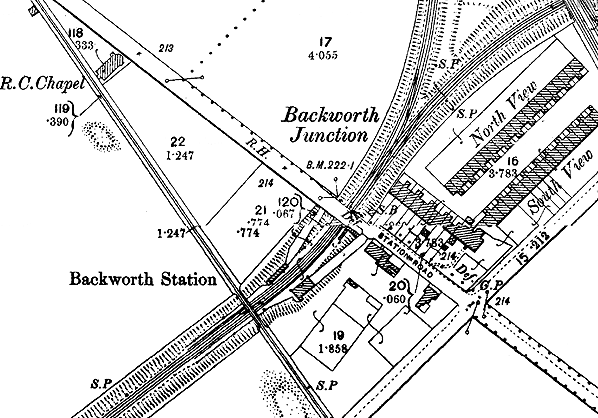
1897 1:2,500 OS Map. The station is shown in its pre-1885 form with passenger facilities provided on the platforms as well as in the building shown below the word ‘Station’ in ‘Station Road’ - which had become the stationmaster’s house c1885. By 1897 the overtrack booking office had been installed adjoining the road bridge, but it is not shown. The single-track Backworth Waggonway can be seen crossing over Backworth station (close to the station’s name). The route to Tynemouth leaves the map heading eastwards whilst the Blyth and Newbiggin tracks diverge to the north. The signal box is marked in its original position to the south-east of the tracks, close to the junction,
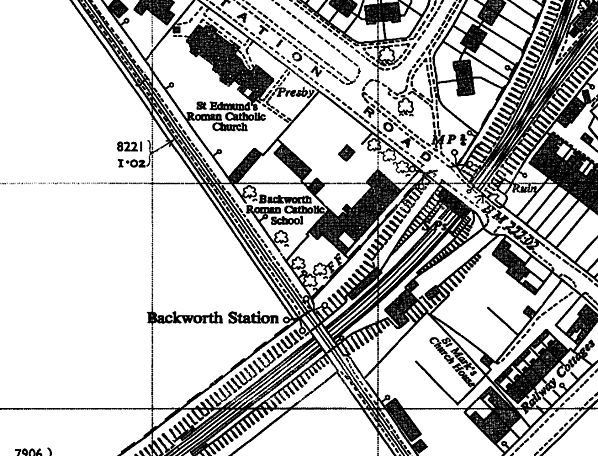
The overtrack building, omitted from the 1897, can be seen adjacent to Station Road overbridge. The old signal box is indicated as ‘Ruin’, and its replacement is between the diverging lines in the north-east corner of the map.
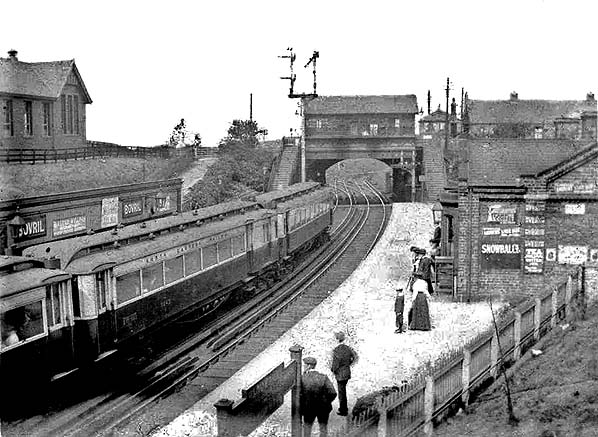 This view on a postcard sent in 1905 shows a new electric multiple unit standing at the down platform at Backworth. It is signalled to take the route towards Tynemouth at the junction beyond the bridge, immediately north-east of the station. Buildings can be seen on both platforms, liberally decorated with metal advertising posters as was common practice until the inter-war years. The wooden overtrack building was installed by the North Eastern Railway in 1885. St Edmund’s School is on the extreme left of the picture.
Photo received from Mick Clark
old15.jpg)
Looking north-east along Backworth’s up platform c1905. The single-storey brick building on this platform with its prominent twin gables and urbane stone bays was formerly the booking office. In 1885 this function was transferred to the wooden shed slung across the tracks adjoining the road bridge. The electric third rails are in place. The two sets of signals can be seen warning of the divergence of the Blyth and Tynemouth lines immediately after the bridge. The signal box, in its original position, can be seen beyond the bridge.
Copyright photo from John Alsop collection
old4.jpg)
Looking south-west from the up platform staircase at Backworth c1910. Two electric units of 1904 stock are passing. The destination blind of the ‘up’ train reads Manors North, a reminder that at this time trains did not cover the entire ‘Coast Circle’: this one would have originated at Newcastle Central, then travelled via Tynemouth. The train at the down platform will be on a Manors North to Central via Tynemouth working. (Until 1917 only the Benton shuttle services used the 1909 link between Central and Manors North.) The waiting facilities on both platforms can be seen, whilst the booking office is in the overtrack building, out of sight behind the photographer. The variety of luggage and sack trolleys in the foreground on the up platform will be noted. The bridge in the background carries the Backworth Colliery railway (formerly Backworth Waggonway) over the Blyth & Tyne line.
Copyright photo from John Alsop collection
The up platform seen from the down platform staircase in 1959. On the extreme left is an LNER running-in board incorporating their early ‘diamond’ device, a feature seen only on Coast Circle stations. It would be replaced within two years with a BR(NE) sign. The ‘mint imperial’ lamps carry LNER nameplates.
Copyright photo from Stations UK
old12.jpg)
In June 1967 electric multiple units made their final appearances on the Coast Circle route; diesel multiple units, formerly confined to the Blyth and Newbiggin services, were phased in to replace them. Seen from the Backworth Waggonway bridge, a dmu is entering the up platform. In the background, to the right, and at a higher level the former stationmaster’s house and offices can be seen, set at right-angles to the platforms; this structure was in the style of the station building at South Gosforth. The former booking office, converted to waiting rooms is on the up platform, with further waiting facilities on the opposite platform. The wooden overtrack building is in use as the booking hall and footbridge.
Photo by J C Dean
old14.jpg)
In this excellent picture from June 1967, looking north-east from the former Backworth Waggonway bridge, an electric multiple unit is leaving the down platform en route to Tynemouth and Newcastle. This was the final month of the electric services. The modest, but attractive, buildings on both platforms are clearly shown, as are the former stationmaster’s house (upper right in the background) and the overtrack building added by the NER in 1885. Station approach roads can be seen serving each platform. This Backworth station did not handle goods traffic, but its predecessor on the route to Seghill (renamed Holywell) continued to provide such facilities after it ceased to be a passenger station.
Photo by J C Dean
On the last day of 1973 the up platform is seen from a DMU. These units had bars fitted to the windows in the passenger doors to prevent passengers from leaning out of them (for instance, to take photographs!) as there were limited clearances and accidents were likely. The author asked permission to use the guard’s window, not fitted with bars, to take this photograph. The BR(NE) running-in board is still in place as is the increasingly vandalised waiting room block.
Photo
by Alan Young
old7.jpg)
On 27 December 1976 the wooden overtrack building, containing the footbridge and booking hall, looks distinctly shabby. BR(NE) livery is still in place, including the station name and ‘totem’ notice board headers, and faded ‘oriental blue’ paint still adorns the door and the window shutters. A few months later this structure was to be demolished.
Photo
by Alan Young
Click here for more pictures of Backworth station
| Last
updated: Sunday, 04-Jun-2017 08:48:46 CEST |
© 1998-2012 Disused Stations
| |

old16.jpg)



old15.jpg)
old4.jpg)
old5.jpg)
old12.jpg)
old14.jpg)
old6.jpg)
old7.jpg)
old8.jpg)
old8.jpg)
2.jpg)
1.jpg)
3.jpg)


2.gif)
.gif)





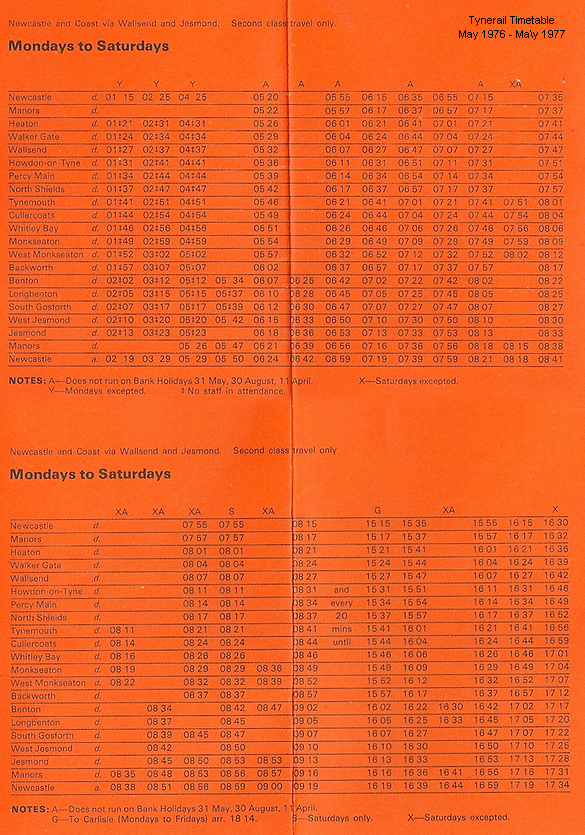



 Home Page
Home Page